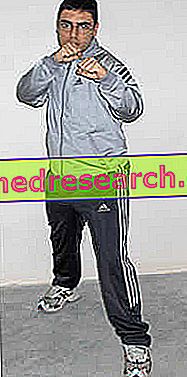The actual combat is often very varied, so much so that its outcome is dependent on such a number of factors that even the most experienced student can only leave out at least some. These forgotten factors can be the cause of defeat even of the strongest fighters following a clash with any thug (an expression that I like very much in this regard and which describes, in my opinion, the situation "nobody is invincible" very well) . However, there is a factor that just cannot be overlooked and that anyone who approaches the study of real combat with bare hands, as much as it may lack attention and intuition, cannot fail to consider it important: it is the capacity, proper and of the opponent (or opponents), to manage the fight at a distance short enough to be able to hit with his fists, that is, at a medium distance, close and short1, since it is at this distance that the combat normally takes place. The direct punch, in particular, is the most useful tactical technique, from the tactical point of view, to dominate the opponent at medium and close range. Obviously, however, like all martial arts shots, in order to achieve its maximum effect, it must be carried out according to technical parameters. Let's see what they are.
THE STARTING POSITION OF THE DIRECT PUNCH:
As with all shots, even for the direct punch it is necessary that the execution starts from a suitable position to guarantee speed and power, therefore suitable for catching the opponent by surprise and hurting him (to prevent him from hurting himself) . The starting position of the direct fist must thus be constructed: the lower limbs must be in a discreet sagittal divaricata2 with the legs just flexed on the thighs; the degree of frontal divaricata must be such that those two imaginary straight lines perpendicular to the ground and each passing through one of the two most lateral points of the basin also pass each by one foot (ideally the aforementioned line should join with another line that divides the foot in one half of the left and one of the right); the angle subtended between that imaginary straight line that divides the back foot into a left half and a right half and the straight line joining the heel of the same foot with the direction in which the opponent is located must be in numerical value as close as possible at 0 °; the same applies to the front foot; the trunk must be kept in a semi-frontal position in relation to the dislocation of the opponent in space; the garment must orient itself in such a position that it is possible to keep the gaze fixed on the adversary (in fact it is necessary to keep the gaze on the opponent during the whole technique). The position of the upper backward limb, ie the upper limb parallel to the posterior lower limb, must be such that the forearm is flexed on the arm; the fist, closed but not firmly tightened, is placed anterior to the mouth. For beginners, it may be appropriate to adopt a slightly different position which, although it does not facilitate the acquisition of the starting position, certainly facilitates the learning of the direct fist technique. This position must be so composed: the forearm in flexion on the arm; the closed fist, but not tightened with force, must be with the knuckles of the fingers next to touch the nearest cheekbone. As for the position of the advanced upper limb (in jargon, "the guiding arm"), it must be in a short position (ie with the forearm flexed on the arm), with the fist closed but not firmly tightened, in so that the hand is exactly in front of the other. Both shoulders must be slightly elevated. Both elbows must lie close to the trunk.
 |  |
IMAGE 1a The starting position of the direct fist seen from the front. Notice the slightly elevated shoulders. This care guarantees the possibility of holding the entire garment under the protection of the upper limbs during the execution of the blow | IMAGE 1b The starting position of the direct fist seen from the side |
 |  |
| IMAGE 2a The alternative starting position (for beginners) seen from the front | IMAGE 2b The alternative starting position (for beginners) seen from the side. |
I will now explain the motivation of each of the aforementioned technical devices to be adopted. We start from the degree of sagittal divaricata that the lower limbs must adopt to assume the starting position and from the degree of bending that the legs must have on the thighs. I will not dwell much on these details since the reasons why it is necessary to keep the legs in sagittal and semi-folded on the thighs is the same for which it must be done in the assumption of the starting position of the circular stock. I therefore recommend, to those who would like more details, to consult the article "technique of circular football in real combat" in the aforementioned paragraph. Here, I limit myself to clarifying that as the degree of sagittal divaricata increases, the angle subtended between the posterior inferior limb and the ground becomes increasingly acute, therefore the vector generated by the distension of the aforementioned limb (this movement which, as will be further explained, it composes the global technique of direct fist) it will have a component towards the front much greater the greater will be the degree of sagittal divaricata of the two lower limbs and a component upwards so much smaller the more the two lower limbs will be kept neighbors. It is therefore necessary to keep the lower limbs in sagittal divaricata in such a way as to guarantee the force generated by the posterior lower limb a direction which leads it to fall against the opponent.
 |  |
IMAGE 3 Taking a very different position in the sagittal plane (image 3a), at the time of the distension of the posterior leg, a vector with a component towards the front is decidedly more important than it would be if one started from a position less divaricata (image 3b). In the latter case, the component with the major modulus of the vector generated by the distension of the rear leg has its upward direction. | |
As regards, instead, the degree of bending of the legs, this should not be too marked because otherwise, besides favoring an excessive extension of the femoral quadriceps, antigravity muscles, (removing the myosin filaments from those of actin3 and thus hindering their sliding one over the other), the median longitudinal axis 4 of the leg moves too far from the thigh one, removing the prop action, exerted by the leg, which facilitates the antigravity action of the quadriceps (and which therefore prevents the onset of fatigue). The bending of the legs on the thighs, on the other hand, must not even be non-existent, because, if this were the case, the femoral quadriceps of the posterior thigh could no longer exert that action of distension of the posterior leg on the thigh that must compose the technique of direct fist and the anterior lower limb would form a prop that would counteract the action of advancing the body following distension of the rear leg. However, as regards the degree of sagittal divaricata, it is necessary to make an invalid clarification for the execution of the circular kick, but important for that of the direct fist: a too strong sagittal divaricata, besides being absurd from a tactical point of view, prevents a correct execution of one of the movements that globally constitute the direct fist technique launched with the backward limb: due to the origins and the insertions of some muscles (which connect the trunk with the lower limb), standing in marked sagittal divaricata it is much more difficult to rotate the trunk around its axis in a clockwise direction if the advanced lower limb is the right one (so if it is to be struck by the left) and in an anti-clockwise direction if the left leg is advanced (yes strikes right). These are the movements that constitute, as will be extensively discussed in the next chapter, the technique of direct fist (especially the one unleashed at medium distance, since here a wider torsion of the trunk is required; for the direct strikes at close range, in fact, one could allow oneself to keep a wider gap, but without exaggerating) and which are invalidated from a starting position with the lower limbs too far apart in the sagittal plane.
- a safe distance, in which one is out of the opponent's reach and one's safety is not threatened by any of the opponent's limbs;
- a long distance or soccer distance, in which there is the possibility of hitting the opponent with kicks but not with fists;
- a medium distance or fist distance, in which the opponent can be effectively hit with punching techniques (or in any case with techniques that use the hands as part of the body that strikes) by extending the forearms completely on the arms;
- a close distance or trapping distance, in which the distance separating from the opponent is approximately equal to the length of the forearm and, at most, another half of the same body segment. At this distance there are blows with the hands and sometimes with the elbows;
- a short distance or close-range distance (clinch), in which the trunk of a fighter is in contact with that of the other (or, at most, a few centimeters away).
By:
 | Marco battle Graduating in physical education Traditional 2nd Dan Karate Black Belt (mainly Shotokan Ryu style). |



